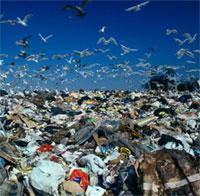
If you have ever wondered, in the face of our ever-expanding landfills and increasingly elaborate packaging of consumer goods and consumption, what happens to the all the garbage, then Heather Rogers' informative and provocative new book, Gone Tomorrow: The Hidden Life of Garbage, published by the New Press, is for you.
It is not a shock that the United States is the number one producer of garbage on the planet; with just 5 percent of the global population we generate 30 percent of the world's trash. The average American throws away a staggering 4.5 pounds of rubbish daily -- that's 1,600 pounds each year, according to Rogers. And garbage is also a global problem; today the middle of the Pacific Ocean is six times more abundant with plastic waste than zooplankton.
So how did we get to this point? Garbage production doubled in the U.S. over the past 30 years, yet waste is increasingly hidden, and the focus on recycling is fading along with it. Rogers says this situation came about through an alignment of manufacturing and marketing forces, combined with goals of the mega-garbage collection companies like Waste Management and Browning Ferris, and even some environmental laws which ended up helping the mega-companies.
Together, the persistent twin emphasis on growth -- our ever expanding consumptive society -- and the encouragement of easy disposal has made it seem painless for us to increasingly evolve to a virtually "throw away" society. With new technologies the impact is particularly pernicious and the impact is often on the Third World, our society's garbage dump. Just think for a moment about how many televisions, computers, screens, cell phones, iPods and other devices and gadgets you and your office have tossed out over the past decade.
Rogers' book, stuffed full of hundreds of fascinating factoids, combines a history of garbage collection with a political analysis of how social and economic forces have created a great garbage monopoly, in much the same way that a few companies dominate many key markets until the "free markets" are no longer remotely competitive.
Mixed in with Rogers' analysis, the reader will encounter fascinating garbage stories of incinerators and mega-dumps, of waste streams and marketing schemes, all aspects of today's waste-addicted culture. Rogers brings an emotional voice to the narrative as the garbage story is both fascinating and appalling, sharing her feelings of being both awe struck and disgusted. Garbage: it really is quite a story.
In the end, while there is plenty to be discouraged about, the book also has heroes and some smart garbage solutions from reformers, ideas to which municipal leaders, like New York's Mayor Bloomberg, are paying some attention.
I think there's a gratification there that people get. It's different for different people. The system that we have wasn't just thought of by huge manufacturers. It was something that was shaped by real human desires that came into play; certain choices were made. We can address this kind of gratification that people get out of the shiny packaging and when something breaks, getting to throw it away and getting a new, fancier one that takes pictures, has lights and plays music. We can try to address those desires in a different way.
Because I think again the environmental movement has, like I say in the book, this sort of pinched, austere approach that isn't that fun for a lot of people. There are so many ways, when I think about what the possibilities. For example: people are building biodiesel cars with old car bodies. They're totally efficient, great vehicles, but they have these old bodies. They don't get 10 miles to the gallon, they get much more.